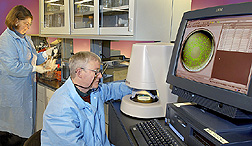New Database Helps Monitor Food Pathogens |
|
 Microbiologist Benne Marmer (left) and technician Tod Stewart use computer-assisted laboratory methods to record growth of Listeria monocytogenes bacteria on ready-to-eat meat products. This information is analyzed in ComBase and then converted to a model in the ARS Pathogen Modeling Program software. (K11054-1) |
A new Agricultural Research Service initiative will help facilitate research cooperation among scientists studying a key food safety issue—how pathogenic bacteria respond to different environmental conditions in food. Scientists in the Eastern Regional Research Center's (ERRC) Microbial Food Safety Research Unit in Wyndmoor, Pennsylvania, and the United Kingdom's Institute of Food Research (IFR) have formed the world's largest online database of predictive microbiology information. Predictive microbiology is a growing field that estimates behavior of microorganisms in response to environmental conditions, including food production and processing operations from the farm to the table. The database, called ComBase, is designed to help make risk assessments and model development easier. It was released at the fourth International Predictive Modeling in Foods Conference in June 2003 and can be found on the World Wide Web at wyndmoor.arserrc.gov/combase. For more than 15 years, ERRC has developed mathematical models of the behavior of bacterial pathogens in food. In February 2002, ERRC established the Center of Excellence in Microbial Modeling and Informatics (CEMMI) to help generate interest in forming partnerships that advance use of predictive models of microorganisms in food. This "virtual laboratory" can be found at www.arserrc.gov/cemmi. CEMMI's objective is to link the expertise of its members to researchers in the food industry, government, and academia. According to coordinator Mark L. Tamplin, the center hopes to improve the way predictive models are developed and then applied to various food-processing situations, while ensuring that users properly interpret results. Predictive microbiology can also benefit the risk-assessment community by solving gaps in research data and enhancing uniformity in experimental designs, he says. ERRC's Pathogen Modeling Program software, a research and instructional tool for estimating the effects of multiple variables on growth, inactivation, or survival of foodborne pathogens, has been available for download since 2002 at www.arserrc.gov/mfs/pathogen.htm. That program and the United Kingdom's Food MicroModel, produced by IFR and the Foods Standards Agency, are both major software packages used to describe bacterial responses to food environments. By combining their efforts and using ComBase to organize the thousands of existing data sets in the hands of scientists and in the literature, ARS and IFR have expanded the uses for this vast amount of information. ComBase, a CEMMI project, already contains around 25,000 growth and survival data set records. The software lets scientists simulate a food environment by entering data—such as temperature, acidity, and available water—and then retrieves all records that match those search criteria. Tamplin says microbiologists in academia, government, and industry are submitting data to ComBase, thus eliminating unnecessary repetition of experiments among laboratories, improving models, and standardizing data sources. More than 1,000 people accessed ComBase data in the first 4 months following its launch. Tamplin says the ultimate success of ComBase relies on collaborators' willingness to deposit more data. "Development of models depends on available data," he says. "We're appealing to professional journals to ask authors to submit all their raw data with their articles, much as they already do for papers about genomic sequences. This would help keep the database timely and offer users the most reliable information."—By Jim Core, Agricultural Research Service Information Staff. This research is part of Food Safety (Animal and Plant Products), an ARS National Program (#108) described on the World Wide Web at www.nps.ars.usda.gov. Mark L. Tamplin is with the USDA-ARS Microbial Food Safety Research Unit, Eastern Regional Research Center, 600 East Mermaid Lane, Wyndmoor, PA 19038; phone (215) 836-3794, fax (215) 233-6581. "New Database Helps Monitor Food Pathogens" was published in the February 2004 issue of Agricultural Research magazine.
|






